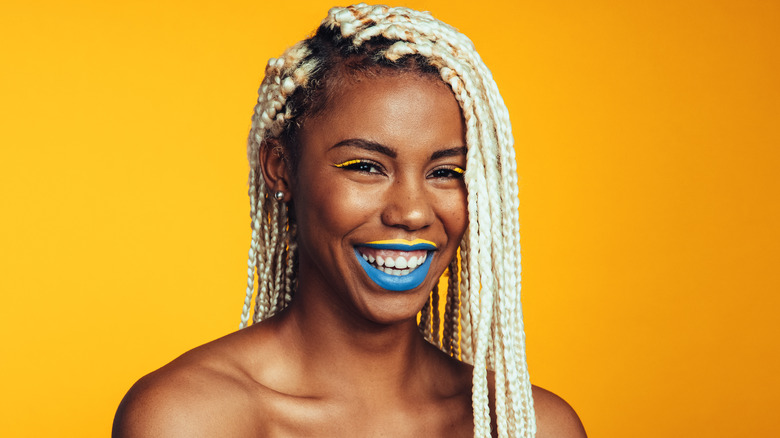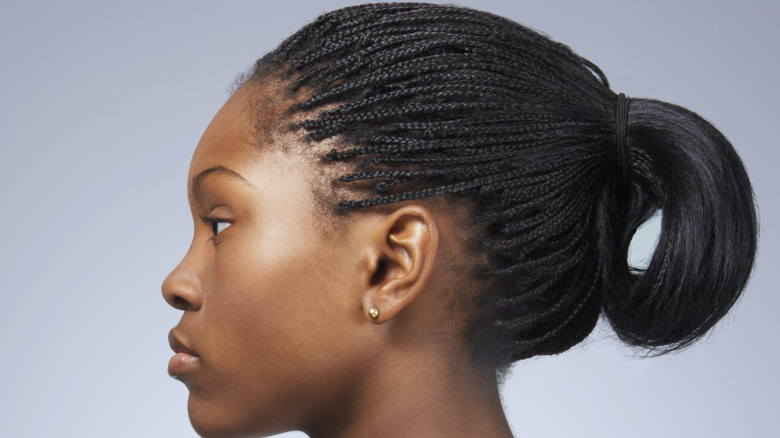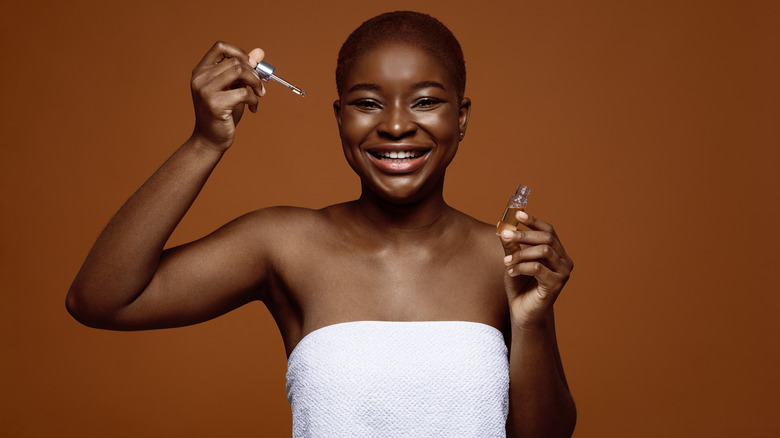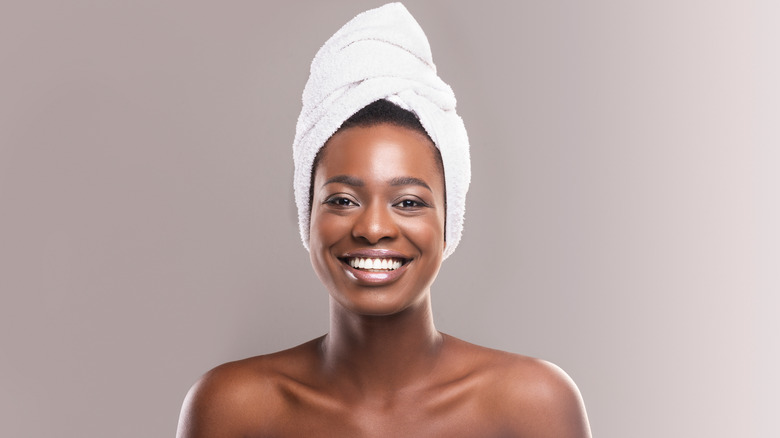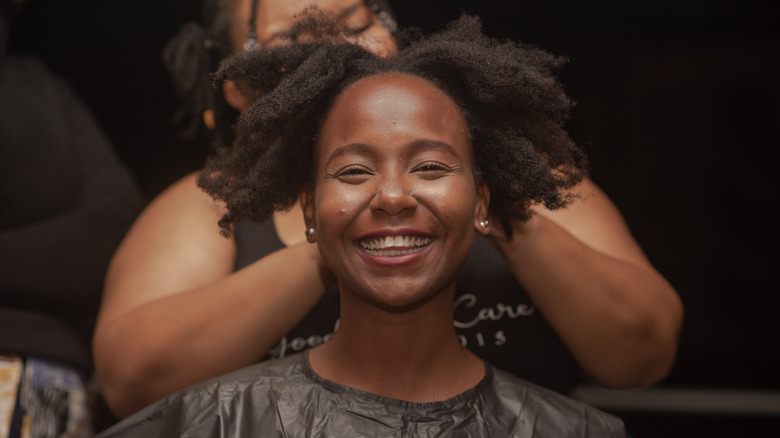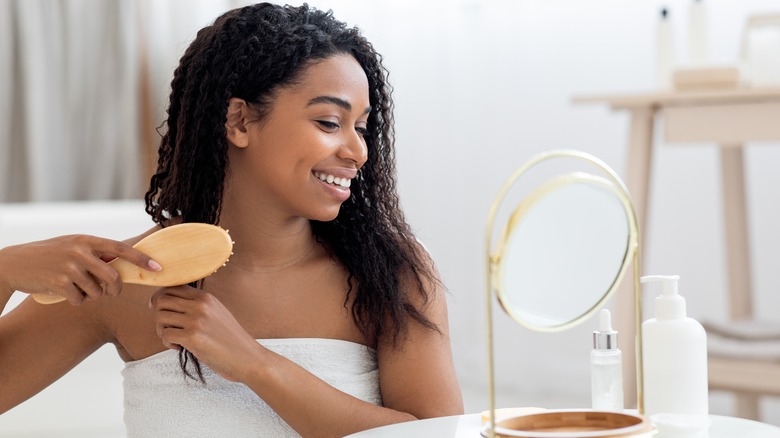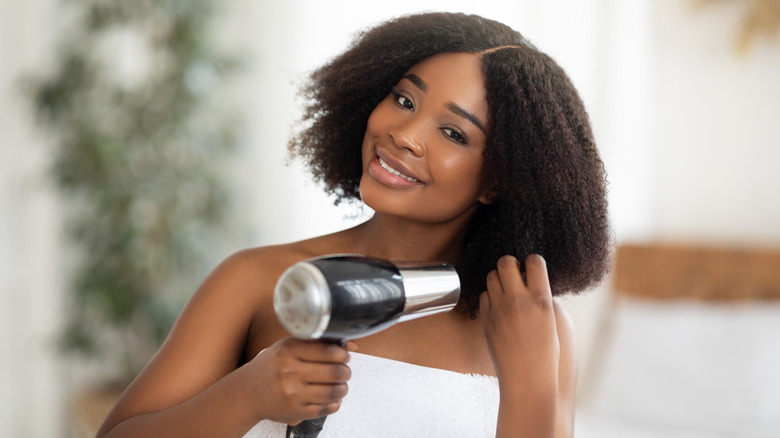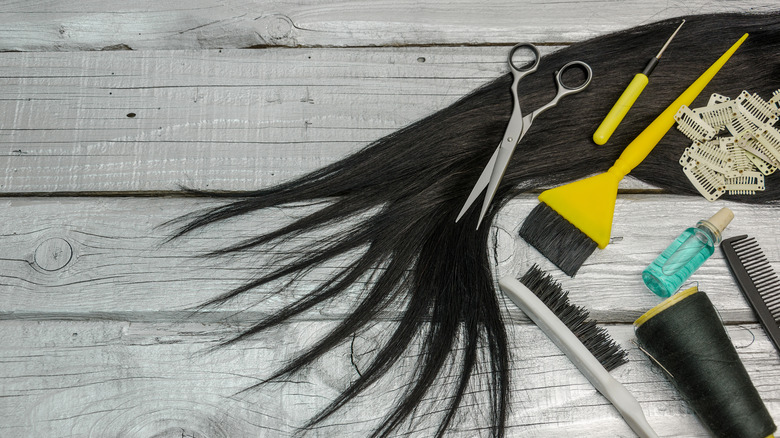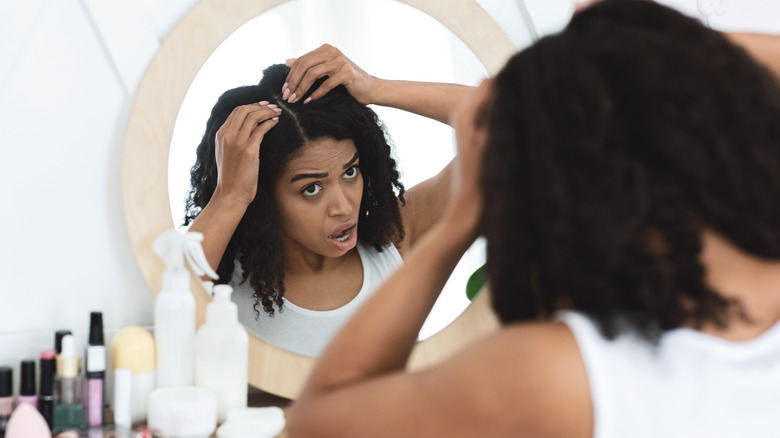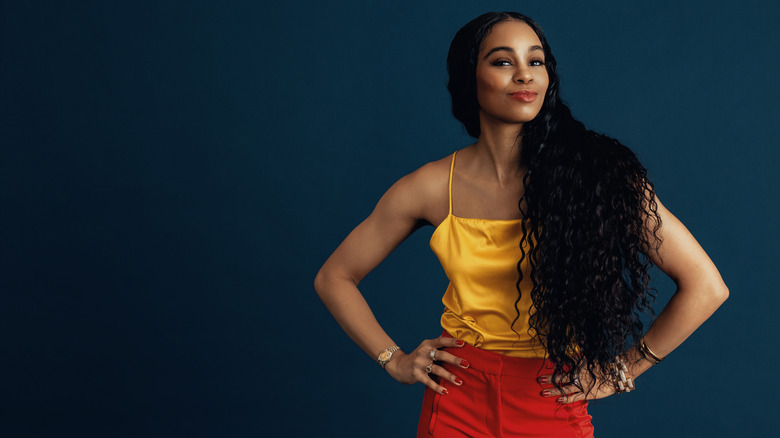How To Keep Your Hair Healthy Under Your Weave
Weave has superpowers — Hollywood stars are proof. If you've ever wondered how your favorite celeb went from having a pixie cut to flowing locks within a matter of days, weave (or extensions) is usually their secret weapon. Now, even though many think that weave and extensions are the same, they are not. According to Refinery29, hair needs to be braided into cornrows before weave is sewn in. Extensions are usually attached to a person's hair (typically unbraided) using clamps or other adhesives.
The reason many people opt for weave is that they want to change up their look. "A weave is a wonderful way to create a new style as it gives you the opportunity to add length to your natural hair," 2013 Afro Hairdresser of the Year, Charlotte Mensah, told Get The Gloss. "Even more importantly, weaves give your own hair a healthy window to rest, grow out a relaxer, and add fullness and body to your hair," she adds.
Before you opt for weave, you need to prep your hair first. According to the American Academy of Dermatology Association, any product build-up needs to be removed, and you need to wash and condition your hair to keep it clean and strong. What some forget, however, is that you need to continue this regimen even after you get weave. Read on for tips on how to keep your natural hair happy and healthy under your weave, so your tresses can look extra amazing when you take it out.
Knowing about different types of weave can help you make an informed choice
All weave is not created equal, and you must keep this in mind when you decide that you're ready to switch up your hairdo.
First, you'll need to choose quality hair that will last longer and isn't made from harmful materials. According to Black Beauty and Hair, the hair type you choose can impact your natural hair, so choose wisely. A lower price usually means the weave is processed — this can harm your natural tresses. Opting for real, ethically sourced human hair is the best route. Your scalp will thank you. The outlet also warns that some cheaper options even include animal hair. Yikes! Cheap weaves also tend to tangle and shed, and you'll be left frustrated and needing a new do much faster than if you paid a little more.
2013 Afro Hairdresser of the Year, Charlotte Mensah, told Get The Gloss that there are different ways to install weave, and the method you choose will depend on the style you want and how long you'd like it to look good. There are five ways weave can be added to your hair: strand-by strand, sewing, fusion, bonding, and interlocking. Mensah recommends the sewing method because it tends to yield the best results for almost any hair type. "Stay away from bonding as this can also result in traction alopecia or balding in certain areas of the scalp," she warns.
Apply oils to your scalp to keep natural hair healthy
If your scalp tends to get flaky while wearing weave, it's a sign that your skin is begging for hydration. This is where oils come in, but make sure you use something you know your skin loves. The last thing you want is to end up with an irritated scalp or clogged pores.
Byrdie recommends you opt for argan or jojoba oil. While potent, they won't weigh down your hair or cause greasiness on your scalp. African Pride adds that castor oil is another excellent option. The fatty acids and vitamin E are miracle workers: Not only do they promote blood flow in your scalp (which means better hair growth, yay!), but they also act as humectants, which means your scalp will be super moisturized and healthy if you use it regularly. Castor oil can also protect hair from dry air and dust, making it a real champ to ensure your natural strands stay healthy under your weave. There is a catch, however. It's best to put the oil on your scalp only, so it's recommended you use a product that has a nozzle so you can control where the oil goes.
Use a nourishing shampoo to keep natural strands healthy
While wearing weave, it can be tempting to skip wash day altogether, but this can lead to unwanted issues like reduced hair growth, dryness, and inflammation. This is usually caused by dirt, sweat, and product build-up, according to African Pride.
You'll want to choose your shampoo carefully — it needs to provide enough hydration to your natural tresses so they can continue to thrive under the weave. African Pride recommends their Moisture Miracle Honey & Coconut Oil shampoo. This formula will thoroughly clean your hair without stripping it of moisture.
Black Doctor recommends you wash your hair once a week, at a minimum. If you can, try to wash your hair separately from the weave — yes, this can be quite a task, but it will ensure your natural hair stays clean and healthy. It's also essential to towel-dry your hair gently after washing. Then comb your faux hair to get rid of any tangles. Once you're done, you can blow-dry your tresses.
Use cleansers with a nozzle, and invest in a microfiber cloth
If imagining the process of washing your hair while wearing weave makes you want to burst into tears, fear not because there's a way to make it easier. Byrdie recommends you try Girl + Hair's nozzled shampoos. Thanks to the nozzle, you can easily distribute the product to your natural strands. You won't have to spend what feels like hours trying to work the product into your hair and scalp — the nozzle will do it for you.
What you do after you wash your hair is just as important. While we've mentioned that towel drying is a good idea, you need to pay attention to the type of towel you use. Microfiber cloth is recommended for those who have sew-in weave — it works great to dry hair, and it's recommended you leave your hair in the cloth for about 20 minutes before you start your usual styling process.
A good conditioner is a must
While shampooing hair is vital to get rid of product build-up and keep your scalp healthy, you should always follow with a good conditioner to ensure your natural hair stays moisturized under your weave.
Yes, you should condition your hair thoroughly before even thinking about getting weave, but it's also crucial your hairstylist continue to add some leave-in conditioner to your strands as they install the faux hair, according to African Pride. It is recommended that you continue to apply a leave-in conditioner to your hair daily after getting your weave. You'll soon notice that any frizz and unruly strands start to disappear, leaving your hair looking gorgeous.
Black Show Hair explains that conditioning natural tresses are crucial to ensuring healthy hair follicles and hair growth. The way they explain it, your scalp is like soil, and your hair is like the plants that grow from it. Without taking care of your scalp and giving it the hydration it needs, your natural hair won't be able to stay healthy or grow. Unlike African Pride, they recommend you apply leave-in conditioner every three days or so. However, they do note that you can do it more frequently if you notice that your scalp tends to be on the drier side. In short: Find what works for you, but remember that no matter your hair type, a leave-in conditioner is a must to keep your tresses healthy under your weave.
Make sure your hairstylist uses quality weave and doesn't sew it in too tight
As with any hair treatment, you must ensure you go to a stylist who knows what they're doing when you plan on getting weave. According to the American Academy of Dermatology Association, you shouldn't be shy to speak up if you notice pain while the stylist is working. Any pulling or discomfort means that the style is too tight, which can put you at risk of developing traction alopecia, which can lead to permanent hair loss.
You should also pay attention to how the stylist attaches the weave to your hair. Hairstylist Christal Mercier, who also performs non-surgical hair replacement, spoke to the Hair Society about things people need to look out for when they get weave. "You don't put adhesive over a perfectly good hairline, or you'll rip your hair out," she cautions. She also warns that cheap weaves are the most common cause of the issues her clients deal with.
Black Show Hair recommends you make sure the stylist sews a net into your hair first before they even attempt to attach the weave. Ask them to do so the second you sit down — your hair will thank you. Not only does the net help to keep your weave in place, but it also protects your natural tresses from experiencing any traction or pulling.
Detangle your hair carefully on a daily basis
While weave can serve as a means to protect your natural hair, it doesn't work unless you put in some effort to care for both your natural and faux hair. One task you'll need to add to your nighttime routine that will ensure your hair stays happy is detangling.
Detangling can be a real pain (literally), but according to Byrdie, it's the only way to ensure the money you spend on your weave is well worth it. It'll make your weave look amazing for longer, not to mention that you won't have to spend hours tugging and pulling at a tangled mess if you only opt to do it once a week. African Pride recommends you gently detangle your hair in the mornings too, and when you're getting ready to shampoo it, detangling is a must. A wide-toothed comb usually works best — use it to comb from the ends to the roots. If tangles are something you struggle with, try applying a pre-shampoo treatment to your tresses before starting the detangling process. To minimize tangling, wear a satin scarf or bonnet around your hair when you go to bed at night.
A blow dryer and dry shampoo are a must
Sweat happens, but it's not the best thing for your hair when you're wearing weave, and that's why it's crucial you keep your hair (and scalp) clean and dry.
According to Black Show Hair, moisture that accumulates (like sweat) can really mess with your weave, causing it to become loose. Not only will slippage cause your sew-in to look unnatural, but it will also pull at your natural hair, damaging it in the process. Speaking to Ebony, "L.A. Hair" co-star Angela Christine explained that leaving weave damp can lead to "a sour mildew smell."
For those who like to work out, keeping sweat from ruining our weave can seem like an impossible task, but luckily, some great products on the market can help us out. Enter dry shampoo. Just a few spritzes on your scalp post-workout will absorb any lingering moisture, Christine told Ebony. Additionally, many dry shampoos are enriched with hair-loving vitamins that can encourage hair growth. Blow drying also works. While this method is a little more time intensive, it effectively dries the scalp and hair. Simply divide your locks into sections, and target them with the blow dryer one at a time. This method can be more drying to your scalp and natural hair, so make sure to spritz some leave-in conditioner into your tresses once you're done to combat any future dryness.
Follow instructions for removal carefully
If you decide to take out your own weave, keep in mind that you'll need a lot of patience. Speaking to Essence, celebrity hairstylist Larry Sims explained that you'll need a few tools to get started: hair oil, conditioner, a paddle brush, two mirrors, and small, sharp scissors are must-haves.
Sims emphasizes that it's crucial you use small scissors (like the type typically used for sewing) to ensure you don't cut off a bunch of your natural hair while trying to remove the weave. Applying oil will help you distinguish between the weave and your natural tresses. Then, it's time to start cutting the threads attaching the weave to your hair. Sims says once you make enough progress, you'll notice that the weave begins to unravel more easily. "You can't rush, you can't give up, you can't rip things out, Sims warns. "You can't just start cutting and pulling because you're frustrated and you want it to be over. That's the biggest don't."
Also, take care not to wet your hair — it will kink almost instantly and make your job harder. Oil or conditioner will work way better to help you cut out the weave and undo your braids with ease. Once you successfully removed the weave, Sims says you should lather on conditioner, wash your hair, and then reapply conditioner. Once you rinse it off, apply a leave-in conditioner for extra, lasting moisture.
Don't leave weave in for longer than recommended
We get it: Saying goodbye to a style that makes you feel like a total baddie can be tough, but you should under no circumstances wear weave for longer periods than recommended, even if it still looks amazing. Yeah, we know it's hard, but remember that your natural hair needs a break every few weeks. According to Black Doctor, removal of weave every six weeks is crucial to deep clean and condition your scalp and hair.
"Keep in mind that the health of your hair is more important than the look," celebrity stylist Monaé Everett told Byrdie, adding that it's good to give your hair a break from the tension and weight it experiences while you're wearing weave. Taking breaks from fancy styles also gives your hair much-needed time to breathe and allows you to moisturize it properly, so it's ready for the next time you want to switch things up. Keeping weave in for too long can also make caring for your natural tresses post-weave a nightmare. Because hair grows fairly quickly (it will grow around ½ to 1-inch while you're wearing weave, per Byrdie), it can end up becoming matted when you don't take out the weave on time. You'll also start to notice that your weave becomes looser and no longer looks natural after a while.
Know that wearing weave will always come with some risks
No long-term hairstyle or treatment is completely risk-free, and the same goes for weave. Speaking to expert trichologists at Philip Kingsley, Get The Gloss discovered that hair specialists tend to worry about traction alopecia the most when it comes to weave, but there is a bright side — if incorrect styling is avoided early enough after symptoms of the condition appear, the damage can be remedied. There is a catch, however. "[O]ver time, irreversible damage can be done if the hair starts to grow back and is pulled out repeatedly. This happens because the constant pulling of the hair from its follicle eventually weakens the growth of the hair, which can cause your hair to grow back finer and even not grow back at all," the team at Philip Kingsley revealed to the outlet.
Aside from potentially causing a receding hairline, wearing weave also makes shampooing challenging. "[I]t is more difficult to do so and there is an extra risk of tangling the weaved hair into the natural hair, leading to poor scalp and hair hygiene and flaky, itchy scalps," experts warn. If you do develop dandruff while wearing weave, it's a good idea to speak to a trichologist so they can recommend the best products. If that's not an immediate option, experts recommend you try the Philip Kingsley Flaky Itchy Scalp Toner. Not only will it stop flaking, but it's also antimicrobial and doesn't need to be rinsed off.
